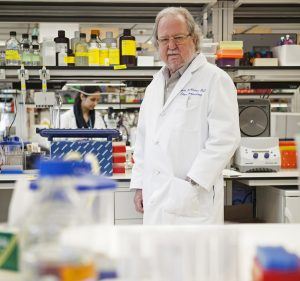 Allison didn’t set out to be a cancer researcher; he dreamed of solving some of the basic mysteries of biochemistry. But in graduate school, when he was assigned to tinker with the formulation of a common chemotherapy for leukemia, his family history prompted him to try an experiment of his own, one that would deeply influence his career direction. Allison wondered what would happen if he injected mice with tumors after they were cured. To his astonishment, the animals didn’t get leukemia again. Somehow, he surmised, their immune systems had learned to kill the tumors.
Allison didn’t set out to be a cancer researcher; he dreamed of solving some of the basic mysteries of biochemistry. But in graduate school, when he was assigned to tinker with the formulation of a common chemotherapy for leukemia, his family history prompted him to try an experiment of his own, one that would deeply influence his career direction. Allison wondered what would happen if he injected mice with tumors after they were cured. To his astonishment, the animals didn’t get leukemia again. Somehow, he surmised, their immune systems had learned to kill the tumors.
The notion of harnessing immune defenses to fight cancer dates back to the 1890s, when a New York surgeon named William Coley learned that some patients with sarcomas went into remission after contracting a Streptococcus infection. It seemed the body’s attack on the microbes wiped out the tumors as well. Coley began inoculating cancer patients with the same strain of strep; a few died of the infection, but others emerged tumor-free. When he switched to dead bacteria, patients’ survival rates improved. Coley’s Toxin, as it became known, was widely used for 40 years. But its results were unpredictable, and the concept of cancer immunotherapy fell out of favor as the field focused on chemotherapy and radiation. Although a few scientists continued to probe the potential of immune-based approaches, their work was mostly ignored.
By 1973, when Allison finished his doctorate, the mechanics of immunity were somewhat better understood than in Coley’s day. For example, researchers had recently identified T lymphocytes, white blood cells that destroy pathogens in several distinctive ways. Each T cell, scientists believed, was programmed to recognize a particular snippet of protein, or peptide, unique to invaders such as bacteria, viruses or tumor cells. These bits of protein are categorized as antigens, substances capable of triggering an immune response. When a T cell detects one, it morphs into a fighting machine, zapping invaders with lethal chemicals, multiplying into an army of identical killers or signaling other immune-system troops to join the attack. Yet exactly how T cells are activated remained largely a matter of conjecture.
More here.